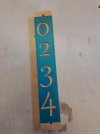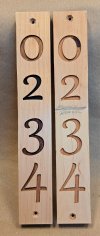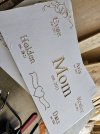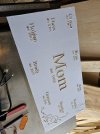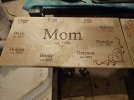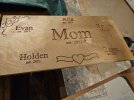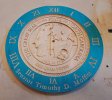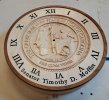After getting several good ideas from fellow WWers, on how to darken cherry under a CNC-cut maple veneer I tested the Oramask film. In a word - Excellent.
Here's the process for those with similar interest:
1) After sanding the maple veneer to 220, coat with 2 coats dewaxed shellac, lightly sanding with sanding pad between coats. Let dry 12 hours to make sure all volatiles are out.
2) Apply Oramask with medium/soft wallpaper roller. Let sit 2 hours.
The attached shows the as-cut mask and a side-by-side comparison of previous cutout and the new mask-cut post-stained. The as-cut has not been cleaned up in any way and it shows very little fuzzies on the film. The 3 was cut first with a 60deg Vee bit with a lot of mileage on it. I then interrupted the CNC and change to a fresh bit. The other numbers were cut with that. Both cleaned up very well with an X-acto. The various stains were just "slogged on" intentionally heavy to see if there was any bleeding. The mask peeled off easily.
As mentioned before, I usually use india ink with a shellac mask for my clock numbers, but will now use the Oramask exclusively since it was so easy. There's a guy on YT touting just using self-stick shelf liner because it's 1/5th the cost and "almost as good". The way I look at it, when cutting $25-100 worth of hardwood, and adding my time for glue-up, planing, etc. - who cares that the film is $10 vs $2?
Here's the process for those with similar interest:
1) After sanding the maple veneer to 220, coat with 2 coats dewaxed shellac, lightly sanding with sanding pad between coats. Let dry 12 hours to make sure all volatiles are out.
2) Apply Oramask with medium/soft wallpaper roller. Let sit 2 hours.
The attached shows the as-cut mask and a side-by-side comparison of previous cutout and the new mask-cut post-stained. The as-cut has not been cleaned up in any way and it shows very little fuzzies on the film. The 3 was cut first with a 60deg Vee bit with a lot of mileage on it. I then interrupted the CNC and change to a fresh bit. The other numbers were cut with that. Both cleaned up very well with an X-acto. The various stains were just "slogged on" intentionally heavy to see if there was any bleeding. The mask peeled off easily.
As mentioned before, I usually use india ink with a shellac mask for my clock numbers, but will now use the Oramask exclusively since it was so easy. There's a guy on YT touting just using self-stick shelf liner because it's 1/5th the cost and "almost as good". The way I look at it, when cutting $25-100 worth of hardwood, and adding my time for glue-up, planing, etc. - who cares that the film is $10 vs $2?

